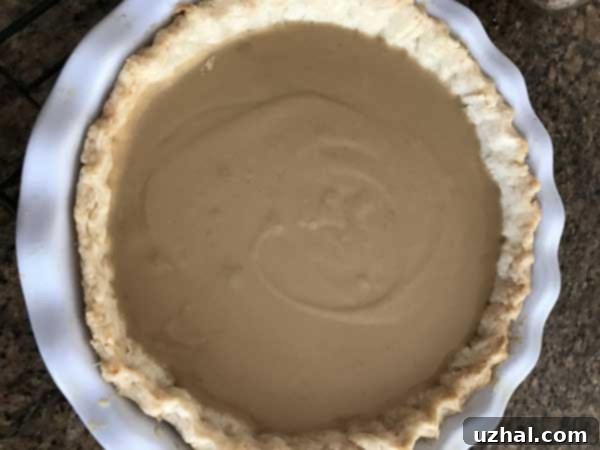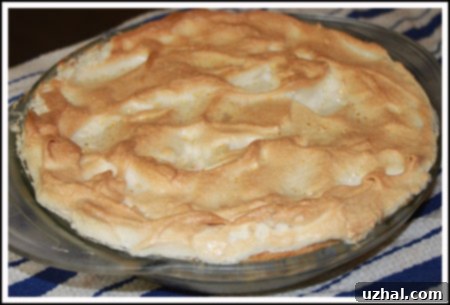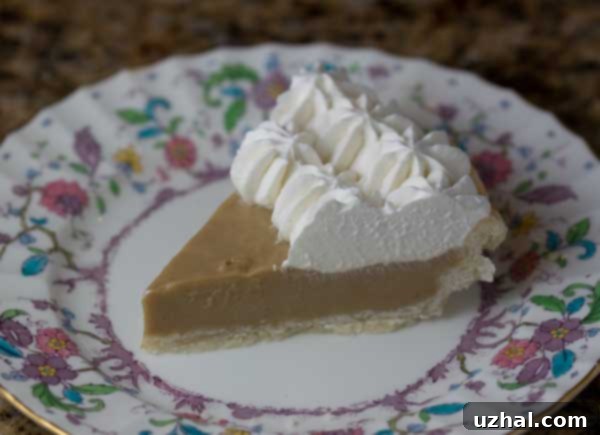The Ultimate Homemade Butterscotch Pie: Our Evolved Recipe for a Creamy, Decadent Classic
There’s something truly magical about a well-made butterscotch pie – that rich, caramel-like sweetness combined with a silky-smooth texture, all nestled in a flaky crust. Over the years, this particular butterscotch pie recipe has become a beloved staple in my kitchen, a dessert I’ve returned to time and again, refining it with each bake. What started as a promising base has slowly but surely evolved into what I now consider the ultimate version, a testament to countless small tweaks and passionate experimentation. The journey of perfecting this pie has been incredibly rewarding, leading to a recipe that consistently delivers a creamy, flavorful, and deeply satisfying experience. Below, you’ll find not just the recipe, but also the insights and tips gleaned from years of making this decadent dessert, alongside some visuals showcasing its delicious transformation.
One of the most significant changes to this recipe, originally based on this classic foundation, has been the topping. While a traditional meringue certainly has its place and offers a beautiful, airy contrast, I’ve come to wholeheartedly prefer a generous topping of fresh, homemade whipped cream. The whipped cream adds an extra layer of luxurious richness and a delightful creaminess that perfectly complements the butterscotch filling. It creates a more decadent mouthfeel and a truly satisfying finish that, in my opinion, elevates the pie to new heights. The subtle sweetness and light texture of the whipped cream provide an ideal balance to the deep, buttery flavor of the filling, making each bite an unforgettable experience. For those who love a classic, meringue remains a viable option, but for sheer indulgence, whipped cream is the way to go.
Another crucial refinement in my quest for the perfect butterscotch pie involves the brown sugar blend. Instead of using just one type of brown sugar, I’ve found that a combination of half dark brown sugar and half light brown sugar yields a significantly more complex and robust flavor. Dark brown sugar, with its higher molasses content, brings a deeper, more intense caramel note, adding layers of rich flavor that can’t be achieved with light brown sugar alone. Light brown sugar, on the other hand, contributes its classic, mellow sweetness. Sometimes, I even push the boundaries a bit, using two-thirds dark brown sugar to one-third light brown sugar to amplify that deep, buttery richness even further. This carefully balanced blend ensures the butterscotch flavor is pronounced and wonderfully nuanced, creating a truly memorable dessert.

Efficiency and consistency are key in baking, and I’ve discovered a simple trick to speed up the process while ensuring a flawlessly smooth filling: warming the milk. A quick warm-up in the microwave prior to mixing makes a world of difference. It helps the sugar dissolve more easily and prevents any lumps from forming when combined with the flour. But beyond convenience, the type of milk you choose is paramount. For a butterscotch pie that truly sets up beautifully with a firm yet luscious consistency, whole milk is non-negotiable. Reduced-fat or skim milk simply doesn’t contain enough fat to provide the necessary structure, often resulting in a runny or overly soft pie. The higher fat content of whole milk contributes to the pie’s luxurious mouthfeel and ensures it holds its shape perfectly when sliced, delivering that classic, satisfying texture.
When it comes to butter, quality truly shines through in this recipe. While regular butter will certainly work, I highly recommend using European-style butter if possible. European butter typically has a higher butterfat content and is often cultured, which imparts a richer, more nuanced flavor and a creamier texture. This slight difference in butter can elevate your butterscotch pie from simply good to absolutely extraordinary. The superior fat content contributes to a silkier filling and a more profound butterscotch flavor, making every bite feel truly indulgent. It’s a small detail, but one that makes a significant impact on the overall decadence and flavor profile of the pie. If European butter isn’t available, a high-quality American butter like Land O’Lakes can be a good substitute, known for its consistent quality.
Finally, the foundation of any great pie is its crust. For this butterscotch pie, a simple, flaky pastry crust is the ideal choice. While graham cracker crusts are delicious for many desserts, they can sometimes overpower the delicate, buttery flavor of the butterscotch filling. A classic plain pastry crust provides a neutral, buttery canvas that allows the rich butterscotch to truly sing. It offers a satisfying textural contrast without competing for attention, ensuring the star of the show remains the incredibly smooth and flavorful filling. Whether you opt for a homemade crust, which adds a personal touch, or a high-quality store-bought option for convenience, make sure it’s baked until golden and crisp before filling.
The Allure of Butterscotch Pie
Butterscotch pie holds a special place in the hearts of dessert lovers, a true comfort food that evokes nostalgia and warmth. Its unique flavor, a blend of caramelized sugar and butter, is distinct from caramel and offers a deeper, often more complex sweetness. This pie is perfect for any occasion, from a casual family dinner to a festive holiday gathering. The beauty of this particular recipe lies in its simplicity of ingredients combined with thoughtful techniques that unlock its full flavor potential. It’s a pie that promises to impress with its rich taste and elegant presentation, making it a reliable choice for anyone seeking a classic, crowd-pleasing dessert.
Ingredient Spotlight and Pro Tips
Understanding your ingredients is crucial for baking success. Let’s delve a little deeper into why certain choices are made for this butterscotch pie and how they contribute to its exceptional taste and texture:
- Egg Yolks: Using only egg yolks creates a custard that is incredibly rich and smooth, without the added protein from egg whites that can sometimes make a custard rubbery. Bringing them to room temperature helps them incorporate more smoothly into the mixture, preventing curdling.
- Brown Sugar Blend: As mentioned, the combination of dark and light brown sugar is paramount. The molasses in dark brown sugar not only provides a deeper color but also a more complex, almost smoky, caramel note that is the hallmark of true butterscotch.
- Whole Milk: The fat in whole milk is essential for creating a stable, creamy custard that sets properly. Lower-fat milk options can result in a thinner, less satisfying filling that struggles to firm up.
- Flour vs. Cornstarch: While some recipes use cornstarch for thickening, flour provides a slightly different texture to the custard – a bit more velvety and less gelatinous. It also contributes to a more stable filling that holds up well.
- European Style Butter: Higher butterfat content (typically 82-84% compared to 80% in American butter) means less water and more rich dairy flavor. This translates directly to a more luscious and flavorful butterscotch.
- Vanilla Extract: Use pure vanilla extract for the best flavor. Add it at the very end, off the heat, to preserve its delicate aromatics.
Troubleshooting Common Butterscotch Pie Problems
Even seasoned bakers encounter challenges. Here are solutions to common issues you might face when making butterscotch pie:
- Runny Pie: The most common culprit is not cooking the custard long enough. Ensure you cook it until it’s visibly thickened and bubbles, then continue for the extra two minutes as specified in the recipe. Chilling for the full recommended time (at least 8 hours, preferably overnight) is also crucial for it to set completely.
- Lumpy Filling: This can happen if the flour isn’t thoroughly whisked into the milk, or if the egg yolks are added too quickly to a hot mixture without proper tempering. Whisking half the warm milk with the flour until smooth, then whisking in the egg yolks, and finally the rest of the milk, helps prevent lumps. Constant whisking during cooking is also key.
- Skin on the Custard: Laying greased waxed paper or plastic wrap directly on the surface of the custard while it cools prevents a skin from forming, ensuring a perfectly smooth top.
- Soggy Crust: Ensure your pie crust is fully baked until golden brown and crisp before adding the filling. Blind baking the crust helps prevent sogginess.
Recipe

Butterscotch Pie — The Best for Now
Cookie Madness
Pin Recipe
Ingredients
- 1 9 inch pie crust homemade or store-bought, blind baked until golden
- 3 large egg yolks at room temperature
- 2 cups whole milk
- 4 tablespoons all-purpose flour
- 1 big pinch salt
- 4 tablespoons unsalted butter preferably European style or high-quality American butter like Land o Lakes
- ½ cup light brown sugar packed
- ½ cup dark brown sugar packed
- 1 teaspoon pure vanilla extract
For the Whipped Cream Topping:
- 1 cup heavy whipping cream chilled
- 2 tablespoons granulated sugar or to taste
- 1 teaspoon pure vanilla extract
Instructions
-
In a small cup or bowl, thoroughly mix the three room-temperature egg yolks together with a fork. Set aside. This ensures they are well-combined and ready for tempering.
-
In a large, microwave-safe glass measuring cup, gently warm the two cups of whole milk in the microwave for 1-2 minutes, or until it’s warm to the touch but not boiling. Warming the milk helps dissolve the sugar and prevents lumps.
-
In a separate medium bowl, whisk together the flour with half (1 cup) of the warm milk until the mixture is completely smooth and free of any lumps. This creates a smooth slurry that will thicken the pie filling evenly.
-
Gradually whisk the prepared egg yolks and the big pinch of salt into the milk/flour mixture. Then, slowly whisk in the remaining cup of warm milk until everything is well combined. Set this mixture aside.
-
In a heavy-bottomed saucepan, melt the butter over medium heat. Once softened, add both the light and dark brown sugars. Whisk or stir continuously for about 2 minutes, or until the butter is fully melted and the sugars have completely dissolved into a smooth, fragrant syrup. Now, gradually whisk the reserved milk and egg mixture into the saucepan. Continue whisking constantly over medium heat. The mixture will begin to thicken and bubble within 2-3 minutes. Once large bubbles start to form and burst, continue whisking for another 2 full minutes to ensure the flour is fully cooked and the custard reaches its optimal thickness. Do not stop whisking to prevent scorching.
-
Remove the saucepan from the heat immediately and stir in the pure vanilla extract. To prevent a skin from forming on the surface of your creamy filling, lay a sheet of greased waxed paper or plastic wrap directly onto the surface of the hot custard, making sure it touches every part. Let it cool at room temperature for approximately 30 minutes.
-
Carefully transfer the cooled butterscotch filling into your pre-baked pie shell. Chill the pie thoroughly in the refrigerator for at least 8 hours, or ideally overnight. This extended chilling time is crucial for the pie to fully set and achieve its perfect sliceable consistency.
-
Shortly before you are ready to serve, prepare the luscious whipped cream topping. In a thoroughly chilled metal bowl, using chilled beaters, beat the cold heavy cream and granulated sugar on medium-high speed until stiff peaks begin to form. Once thick, beat in the vanilla extract. You can then spread the whipped cream evenly over the chilled pie or pipe it decoratively around the edges.
Notes
